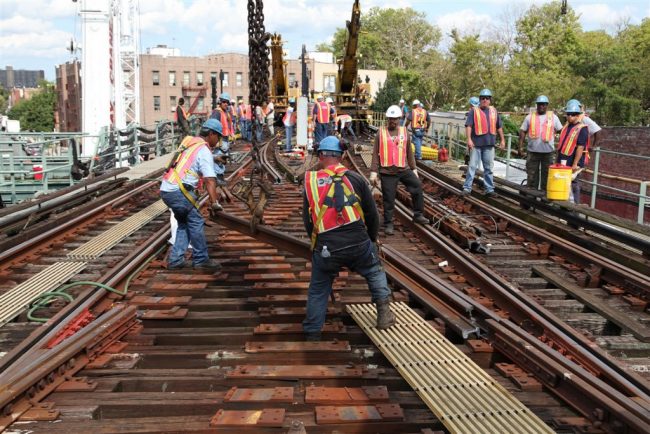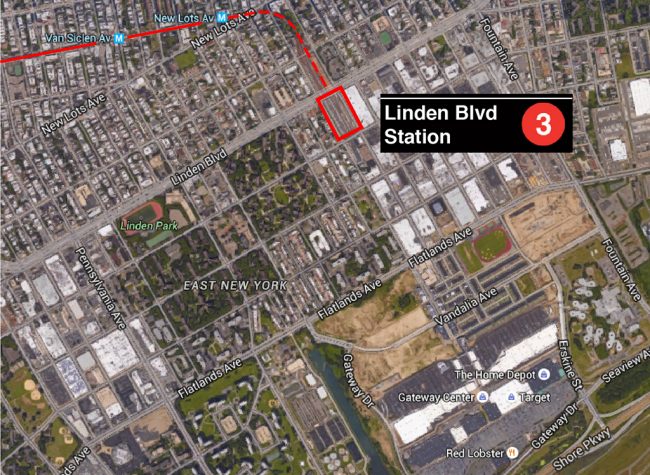
We are celebrating 15 years — and counting — of stories that are deeply researched and deeply felt, that build a historical record of what the city has been.
We are celebrating 15 years — and counting — of stories that are deeply researched and deeply felt, that build a historical record of what the city has been.

Workers replace panels of track near New Lots Avenue on the 3 train, 2012 | Photo courtesy of MTA / Leonard Wiggins
Imagine there were the possibility for the Metropolitan Transportation Authority to extend a subway line to a major concentration of new affordable housing — and a neighborhood with some of the longest commutes in the city — without building a single foot of new subway track.
That chance exists right now in East New York, where the 3 train’s tracks continue nearly a half-mile beyond their current terminal at New Lots Avenue to the Livonia maintenance yard, near the Gateway Center mall, Spring Creek Nehemiah, and several large public housing projects. Using these tracks for passenger service would significantly enhance transit access to a major development area at a low cost, and spread the city’s current subway expansion program beyond Manhattan.
There is a remarkable precedent for such a project — right at the other end of the 3 train, in Harlem. In 1968, large, new, affordable housing developments were being built above and around the site of the Lenox Avenue Yard, the storage yard of the original 1904 subway. Pressed by local residents, the Transit Authority (the predecessor of the MTA) decided to convert yard access tracks into a new station at 148th Street.
Building such an extension is far less expensive than building a new subway line from scratch. Since the tracks already exist — and the yard makes land available for a surface station — there is no need for multi-billion-dollar underground construction. The last new surface station built in the city was the Metro-North station at Yankee Stadium, which cost a little less than $100 million in 2009. While not a perfect comparison, it offers a reasonable order of magnitude figure for the cost of building a station at Livonia Yard. Pushing the 7 train to Hudson Yards, by contrast, cost $2.4 billion.
The only other cost would be replacing the converted train storage tracks. (Only a small part of the yard would need to be converted, and the existing maintenance facility could remain.) Trains could be stored at other yards in the “A division” of the subway (the narrow-car ex-IRT), where the MTA has indicated that slack is available. Much of the work could be joined with the $91.4 million renovation at the Livonia Yard that is included in the MTA’s 2015-2019 Capital Program.
Spring Creek, which would be served by the new extension, is both fast-growing — no Brooklyn neighborhood has added more residents since 1940 — and transit-deprived. It has been the site of major new affordable housing construction in recent years, including the Bloomberg-era 2,200-unit Spring Creek Nehemiah project. The nearby Spring Creek Towers, which opened in 1974 as Starrett City, comprise 5,881 Mitchell-Lama units.
Right now, Spring Creek has some of the longest average commutes in the city, at 48.9 minutes. The extension would follow part of the route of the B6, which has over 40,000 riders on an average weekday and is one of the busiest bus routes in the city. And it would shorten or replace the route of the B84 shuttle, which takes riders from the Gateway Center to New Lots Avenue station — where ridership is up 15 percent since 2009.

Dotted line marks existing track that could be converted for passenger use to serve a hypothetical Linden Blvd Station | Graphic by Urban Omnibus
Mayor de Blasio’s recent announcement of plans for a streetcar line in rapidly developing areas of Brooklyn and Queens reinforces the need for attention to an equally fast-growing but too-often-ignored part of the city. The mayor has expressed interest in the Utica Avenue subway, a long-delayed project that would serve a busy bus corridor in a predominantly low-income community. But given the capital funding constraints on the MTA, this is likely out of reach for the foreseeable future. The 3 train extension could be an equally powerful symbol of transit equity, but has the benefit of being readily achievable in the short term.
Today, this project is under the radar, but a more ambitious plan to extend the line three blocks further to Flatlands Avenue was part of the 1968 MTA Program for Action. Unfortunately, most of that plan was abandoned as a result of the city’s financial crisis. While using the existing track alone would shave more than 10 minutes off the walk to the subway for most residents of the Spring Creek area, a further extension to Flatlands, which would require the expropriation and demolition of some industrial buildings, would put the new station right in the heart of the development area. It is a more ambitious option worth considering, but it does not diminish the value of the simpler conversion of the existing yard tracks into a new station.
Improved transit access would both help residents reach jobs in the city and incentivize further construction. New York’s rail yards are too often seen merely as development sites. Why not use them to improve transportation too?
The views expressed here are those of the authors only and do not reflect the position of The Architectural League of New York.
Comments